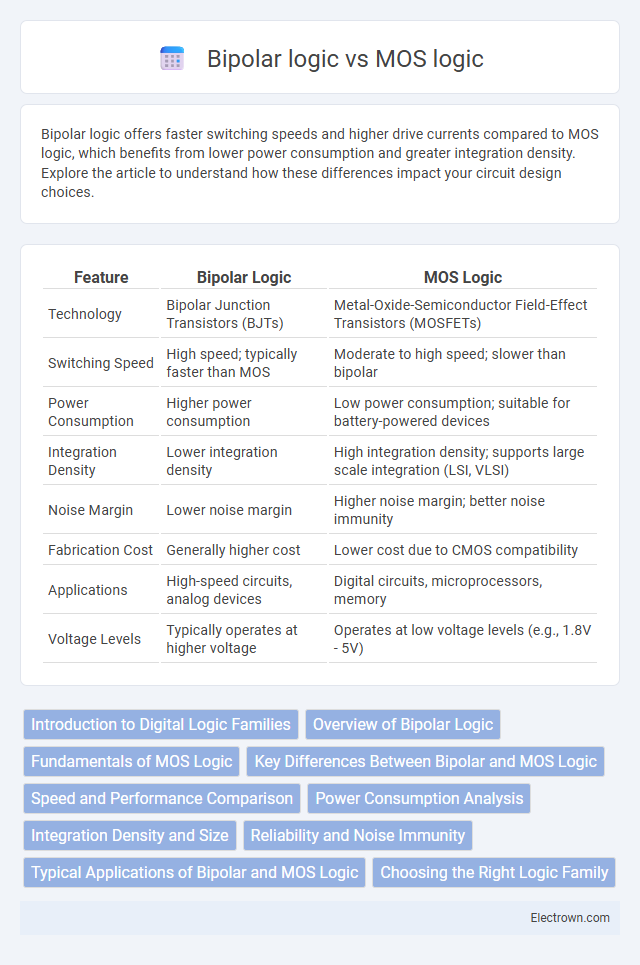Bipolar logic offers faster switching speeds and higher drive currents compared to MOS logic, which benefits from lower power consumption and greater integration density. Explore the article to understand how these differences impact your circuit design choices.
Table of Comparison
| Feature | Bipolar Logic | MOS Logic |
|---|---|---|
| Technology | Bipolar Junction Transistors (BJTs) | Metal-Oxide-Semiconductor Field-Effect Transistors (MOSFETs) |
| Switching Speed | High speed; typically faster than MOS | Moderate to high speed; slower than bipolar |
| Power Consumption | Higher power consumption | Low power consumption; suitable for battery-powered devices |
| Integration Density | Lower integration density | High integration density; supports large scale integration (LSI, VLSI) |
| Noise Margin | Lower noise margin | Higher noise margin; better noise immunity |
| Fabrication Cost | Generally higher cost | Lower cost due to CMOS compatibility |
| Applications | High-speed circuits, analog devices | Digital circuits, microprocessors, memory |
| Voltage Levels | Typically operates at higher voltage | Operates at low voltage levels (e.g., 1.8V - 5V) |
Introduction to Digital Logic Families
Bipolar logic and MOS logic represent two fundamental digital logic families used in circuit design. Bipolar logic, primarily realized through TTL (Transistor-Transistor Logic), offers high speed and noise immunity due to bipolar junction transistors, while MOS logic, exemplified by CMOS (Complementary Metal-Oxide-Semiconductor), provides low power consumption and high integration density. The selection between bipolar and MOS logic families depends on application requirements involving trade-offs among speed, power efficiency, and manufacturing complexity.
Overview of Bipolar Logic
Bipolar logic, primarily exemplified by Transistor-Transistor Logic (TTL), utilizes bipolar junction transistors (BJTs) to achieve fast switching speeds and high noise immunity, making it suitable for high-speed digital circuits. This logic family operates with a typical supply voltage of 5V and exhibits higher power consumption compared to MOS logic due to continuous current flow through BJTs. Bipolar logic's inherent advantages include low output impedance and robust drive capability, enabling reliable interfacing with other digital components in complex systems.
Fundamentals of MOS Logic
MOS logic is based on metal-oxide-semiconductor field-effect transistors (MOSFETs), which control current flow using voltage applied to a gate terminal, enabling high input impedance and low power consumption. Fundamental MOS logic gates utilize n-channel and p-channel MOSFETs arranged in complementary configurations (CMOS) to achieve efficient switching and noise immunity. This technology is favored for large-scale integration due to its scalability, reduced manufacturing complexity, and ability to operate at lower voltages compared to bipolar logic.
Key Differences Between Bipolar and MOS Logic
Bipolar logic utilizes bipolar junction transistors (BJTs), offering high speed and current-driving capability, whereas MOS logic relies on metal-oxide-semiconductor field-effect transistors (MOSFETs), providing low power consumption and high input impedance. The voltage swing in Bipolar logic is typically lower, enabling faster switching times, while MOS logic circuits benefit from simpler fabrication and smaller device sizes, crucial for integration density. Your design choice depends on balancing speed requirements with power efficiency and integration goals in digital circuit applications.
Speed and Performance Comparison
Bipolar logic circuits exhibit higher switching speeds due to their low base resistance and high transconductance, making them ideal for high-frequency applications. MOS logic, particularly CMOS technology, offers lower power consumption but generally slower switching speeds compared to bipolar counterparts. The trade-off between bipolar and MOS logic lies in the balance between speed and power efficiency, with bipolar logic preferred for maximum performance and CMOS favored in low-power integrated circuits.
Power Consumption Analysis
Bipolar logic circuits exhibit higher power consumption due to continuous current flow in their transistor junctions, typically ranging from milliwatts to hundreds of milliwatts per gate, whereas MOS logic circuits, especially CMOS, consume significantly less power by operating primarily during switching events. MOS logic offers power consumption in the microwatt to milliwatt range per gate, benefiting from high input impedance and the absence of steady-state current, making it suitable for low-power applications. The contrast in power efficiency positions CMOS logic as the preferred choice in battery-operated and portable devices where minimizing energy usage is critical.
Integration Density and Size
Bipolar logic circuits generally exhibit lower integration density and larger chip size compared to MOS logic due to their higher power consumption and more complex fabrication processes. MOS logic enables significantly smaller transistor sizes, allowing for higher integration density and more compact circuit layouts on a single chip. Your choice between bipolar and MOS logic impacts the achievable integration scale and overall silicon area efficiency in electronic designs.
Reliability and Noise Immunity
Bipolar logic circuits offer higher noise immunity and faster switching speeds due to their current-driven operation, making them more reliable in high-frequency applications compared to MOS logic. MOS logic, while more power-efficient, can be more susceptible to noise and radiation-induced errors, impacting its reliability in harsh environments. Choosing the appropriate logic family depends on Your system's requirements for speed, power consumption, and operational stability under noisy conditions.
Typical Applications of Bipolar and MOS Logic
Bipolar logic is typically used in high-speed and high-frequency applications such as radio frequency circuits, video amplifiers, and analog signal processing due to its fast switching and high gain characteristics. MOS logic is more common in low-power digital circuits like microprocessors, memory chips, and portable electronic devices because of its low power consumption and high integration density. Your choice between bipolar and MOS logic depends on whether speed or power efficiency is the primary requirement for the application.
Choosing the Right Logic Family
Choosing the right logic family depends on your project's speed, power consumption, and integration needs, with bipolar logic offering high-speed switching and robust noise immunity suitable for performance-critical applications. MOS logic, including CMOS, excels in low power consumption and high integration density, making it ideal for battery-powered or high-complexity circuits. Evaluating your requirements for speed, power efficiency, and circuit complexity will guide you to select bipolar logic for speed or MOS logic for energy efficiency and scalability.
Bipolar logic vs MOS logic Infographic

 electrown.com
electrown.com